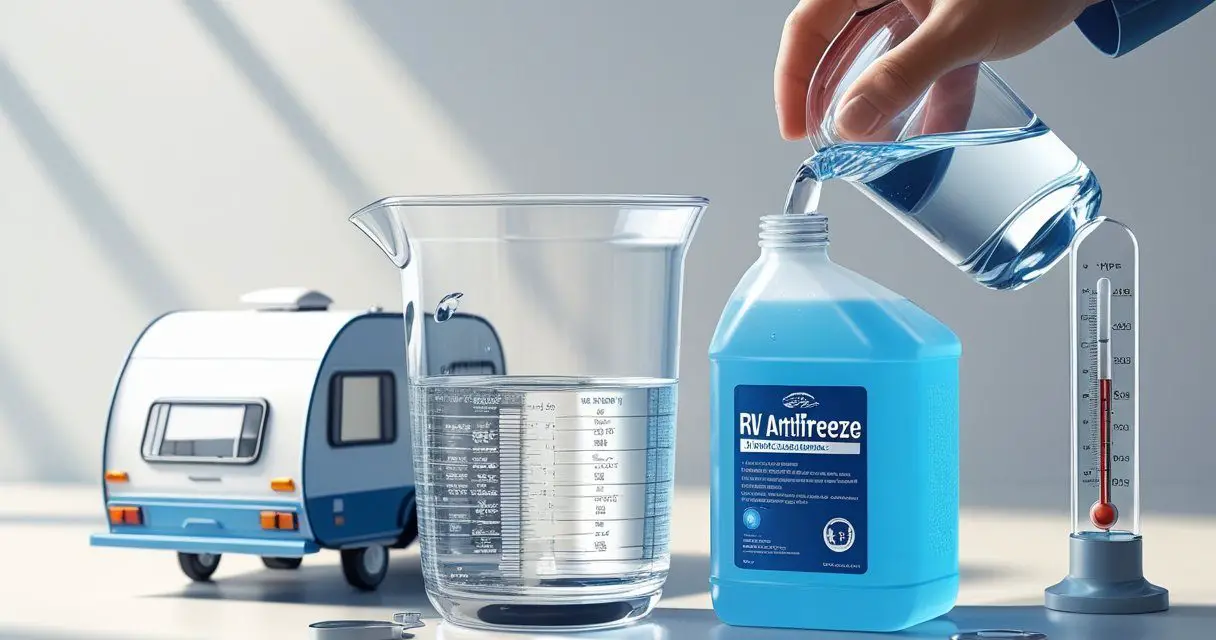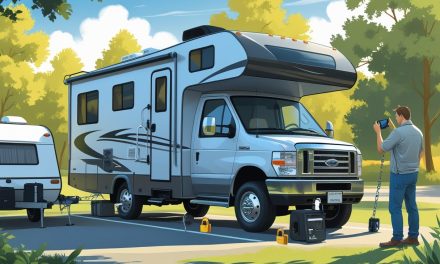Would you like to save this article?
When it’s time to winterize your RV, you may wonder if you can stretch your antifreeze by mixing it with water. You should not dilute ready-to-use RV antifreeze because it will lose its ability to protect your plumbing system from freezing.
The pre-mixed formula is designed to work at full strength. Adding water raises the freezing point, leaving your pipes at risk.
There is one exception: some antifreeze is sold as a concentrate, and that type is meant to be mixed with water according to the label. The key is knowing which kind you have before pouring anything into your system.
Using the wrong mixture can cause damage that costs far more than a jug of antifreeze.
Key Takeaways
- RV antifreeze must be used as directed to protect plumbing.
- Diluting pre-mixed antifreeze weakens freeze protection.
- Correct use depends on knowing if it’s concentrate or ready-to-use.
Understanding RV Antifreeze
RV antifreeze protects your plumbing system from freezing temperatures and damage during storage. It is designed to be safe for potable water systems while still effective at lowering the freezing point of any water left in your lines.
What Is RV Antifreeze?
RV antifreeze is a liquid solution that prevents water in your RV plumbing from freezing and expanding. Unlike automotive antifreeze, it is non-toxic and safe for use in systems that carry drinking water.
You use it by pumping it through your RV’s water lines, faucets, and drains. The bright color, often pink, makes it easy to see when the system is fully filled.
RV antifreeze is not meant for your engine. It is specifically made for the freshwater and waste systems in your trailer, camper, or motorhome.
Using the wrong type can cause health risks and damage to your plumbing.
Types of RV Antifreeze
There are two main types: ethanol-based and propylene glycol-based. Both lower the freezing point of water, but they differ in how they affect your RV.
- Ethanol: Less expensive but can dry out or damage rubber seals. It has a stronger odor and taste, which may linger in your water system.
- Propylene glycol: More common and preferred. It is odorless, tasteless, and less likely to harm seals or fittings. This is often labeled as propylene glycol RV antifreeze.
Some products are sold as concentrates that you dilute with water according to instructions. Others are ready-to-use and should not be mixed further.
Always check the label to avoid reducing protection.
How RV Antifreeze Works
When water freezes, it expands and can crack pipes or fittings. RV antifreeze lowers the freezing point of any water left in the system, preventing damage.
The solution mixes with small amounts of water in your lines and still provides protection. This is why you should not dilute ready-to-use antifreeze—it already accounts for residual water.
Propylene glycol RV antifreeze also coats the inside of pipes and seals. This adds a layer of lubrication that helps prevent drying or cracking during storage.
By filling your system until the liquid runs visibly through each faucet, you ensure full coverage and freeze protection.
Can RV Antifreeze Be Diluted?
RV antifreeze is sold in both ready-to-use and concentrated forms. How you handle it depends on which type you buy.
The strength of the solution directly affects how well your plumbing is protected from freezing temperatures.
Effects of Diluting RV Antifreeze
When you dilute a ready-to-use RV antifreeze, you reduce its ability to protect your plumbing system. The labeled freeze protection, such as -50°F burst protection, only applies when the product is used at full strength.
If you add water, the antifreeze may freeze at higher temperatures. This can lead to cracked pipes, fittings, or water pumps if the liquid expands inside the system.
Some water is already left behind in your RV lines after draining. This leftover water already weakens the antifreeze slightly, so starting with a diluted product makes the risk worse.
You should only dilute antifreeze if you purchased a concentrated formula that specifically requires mixing. Otherwise, dilution lowers effectiveness and increases the chance of freeze damage.
Manufacturer Recommendations on Dilution
Most RV antifreeze sold in stores is pre-mixed and labeled as ready to use. These products should not be diluted any further.
The manufacturer guarantees freeze and burst protection only at the listed strength. Some brands also sell concentrate versions.
These require you to add a set amount of water, usually distilled water, to reach the proper ratio. The instructions on the label tell you exactly how much to mix.
Adding too much water will raise the freezing point. If you mix less water than required, the solution may become too thick for your pump to handle.
Always check the label before using any antifreeze. If it says “ready to use,” do not add water.
If it says “concentrate,” follow the mixing instructions carefully.
Testing Dilution Ratios
If you are unsure about the strength of your RV antifreeze, you can test it. A hydrometer or refractometer is commonly used to measure freeze protection levels.
These tools give you a reading of the temperature at which the solution will freeze. Testing is most useful if you mixed a concentrate or if you suspect water may have entered your system.
If you accidentally added too much water, testing lets you confirm whether the mixture is still safe. You should aim for the protection level listed on the container, such as -50°F.
If your test shows a higher freeze point, drain the system and replace it with fresh antifreeze.
By testing, you avoid guessing and ensure your RV plumbing stays protected through freezing temperatures.
Impact of Diluted RV Antifreeze on Winterization
When you dilute RV antifreeze, you lower its ability to keep water lines safe during freezing temperatures. This can lead to reduced protection for your plumbing system and increase the chance of damage.
Protection Limits in Freezing Temperatures
RV antifreeze is designed to protect your plumbing system down to a specific temperature, such as -50°F or -100°F. These ratings only apply when the antifreeze is used at full strength.
If you dilute it with water, the protection rating changes. For example:
| Antifreeze Rating | Full Strength Protection | Diluted 50% |
|---|---|---|
| -50°F | Protects to -50°F | Protects only to about -20°F |
| -100°F | Protects to -100°F | Protects only to about -50°F |
Even a small amount of dilution can reduce the effectiveness enough that your pipes may freeze in normal winter conditions. This is especially risky if you store your RV in areas where temperatures regularly drop below zero.
Because water remains in your lines even after draining, antifreeze must stay at full strength to handle that extra moisture. Diluting it leaves less margin for error, which means your system may not be fully protected.
Risks of Insufficient Concentration
When antifreeze is too weak, your RV plumbing system faces several risks. The most common issue is burst pipes, which happen when frozen water expands inside PEX or PVC lines.
Repairs can be costly and time-consuming. Diluted antifreeze can also fail to protect valves, pumps, and seals.
Ethanol-based antifreeze in particular may already stress rubber seals, and dilution can make the problem worse by allowing ice to form around those parts.
Another concern is inconsistent distribution. As you pump diluted antifreeze through your system, the mix may not fully displace water in low spots or traps.
This leaves pockets of plain water that can freeze solid. By using antifreeze at the recommended strength, you ensure that every part of your plumbing system receives consistent freeze protection.
Dilution reduces that reliability and increases the chance of damage during RV winterization.
Application in RV Water Systems
RV antifreeze protects plumbing from freeze damage, but how you apply it depends on the part of the water system. The way you treat freshwater lines is different from how you handle the fresh water tank or the holding tanks.
Freshwater System Considerations
When winterizing your freshwater system, you need to run antifreeze through every line and fixture. This includes faucets, showers, and low-point drains.
Doing so ensures no water remains that could freeze and damage pipes. You should not dilute pre-mixed RV antifreeze before adding it to the lines.
It is already balanced to provide freeze protection. If you use concentrate, follow the label instructions carefully.
Adding too much water reduces effectiveness and increases the chance of burst pipes. Most RV antifreeze is pink, making it easy to see when it has filled the system.
Run the pump until you see pink liquid at each fixture. This confirms that the antifreeze has displaced any remaining water.
Using Antifreeze in Fresh Water Tank
It is not recommended to pour antifreeze directly into your fresh water tank. Doing so can make it harder to flush the system later and may leave a lingering taste.
Instead, you should bypass the tank and pump antifreeze directly into the plumbing lines. If your RV does not have a bypass kit, you can install one or use a hand pump to introduce antifreeze.
This avoids filling the fresh water tank with non-toxic chemicals that are safe but unnecessary for tank storage. The fresh water tank should be drained completely before storage.
Leaving water inside increases the risk of freezing and cracking. A dry tank is easier to sanitize in the spring and helps keep your drinking water system clean.
Gray and Black Tank Usage
Your gray and black tanks also need protection, but the process is different. After draining and cleaning both tanks, pour a small amount of undiluted RV antifreeze into each one.
This covers the valves and seals, preventing freeze damage. Typically, one to two quarts per tank is enough.
You should also add antifreeze to each drain trap inside the RV. This includes sinks, showers, and toilets.
Doing so keeps water in the traps from freezing and cracking the P-traps. Avoid dumping antifreeze directly onto the ground or into storm drains.
Instead, dispose of it at an approved RV dump station when de-winterizing. This ensures safe handling of the liquid and keeps your holding tanks in good condition.
Best Practices for Using RV Antifreeze
RV antifreeze works only when used correctly, and mistakes like diluting it or skipping proper flushing can reduce its effectiveness. You need to focus on using it at the right strength, preparing your system for spring, and handling disposal in a safe way.
Proper Dilution Methods
RV antifreeze is designed to be used at full strength. Unlike automotive antifreeze, you should never mix it with water on purpose.
Dilution lowers its freeze protection and leaves your plumbing at risk in cold weather. When you pump antifreeze through your water lines, it will mix slightly with small amounts of water left behind.
This is normal and expected. What you want to avoid is adding water directly to the antifreeze before use.
Most RVs need about 2–4 gallons to winterize fully, depending on the size of the system. Make sure to run antifreeze through all faucets, the toilet, and into the P-traps so no standing water can freeze and crack the pipes.
Flushing and De-Winterizing
In spring, you need to flush the antifreeze out of the system before using your RV again. Start by draining the fresh water tank and filling it with clean water.
Run the water pump and open every faucet until the water runs clear. You should also flush the toilet and outside shower if your RV has one.
Don’t forget the low-point drains, which help remove any leftover antifreeze from the lines. Even though RV antifreeze is non-toxic, you don’t want to drink water that has traces of it.
Run extra water through the system to make sure it is fully cleared before using it for cooking or drinking.
Disposal and Environmental Safety
RV antifreeze is usually made with propylene glycol or ethanol. Both are less harmful than automotive antifreeze, but you should still dispose of them responsibly.
Do not pour antifreeze directly onto the ground or into storm drains. Instead, collect it in a container and take it to a local waste facility that accepts household chemicals.
Some areas allow small amounts to be poured into a sanitary sewer, but you should check local rules first. When draining antifreeze from P-traps or tanks, use a bucket to catch the liquid.
This prevents spills and keeps it from entering the soil or groundwater.
Common Mistakes and Troubleshooting
Using RV antifreeze the wrong way can lead to plumbing damage, frozen pipes, or wasted product. Paying attention to dilution and knowing the warning signs of poor protection will help you avoid costly repairs.
Avoiding Over-Dilution
RV antifreeze is usually sold ready to use. If you add water to this type, you weaken its ability to protect your plumbing in freezing temperatures.
Even small amounts of extra dilution can raise the freezing point and leave your pipes at risk. Concentrated antifreeze is different.
It requires mixing with water, but only in the exact ratio listed on the label. Adding more water than directed reduces its effectiveness, which could lead to cracks in fittings or burst lines.
Keep in mind that some water will already be in your RV system. Trapped water in pipes or low spots mixes with antifreeze as you pump it through.
This is why you should always use antifreeze at full strength unless the product specifically says otherwise.
Tip: Use a table like this to check your product type:
| Antifreeze Type | Dilution Allowed | Notes |
|---|---|---|
| Pre-mixed (pink) | No | Use straight from the container |
| Concentrate | Yes | Follow manufacturer’s instructions |
Recognizing Signs of Inadequate Protection
If your RV antifreeze is too diluted, you may notice changes before damage occurs. One sign is slush forming in low spots of the plumbing when temperatures drop.
Another indication is water flow slowing or stopping because ice has begun to form in lines. You may also see cracks in plastic fittings or leaks around seals once temperatures rise again.
These often show that the antifreeze did not protect the system during freezing weather. Check the label for the lowest temperature rating.
If you live in a region where winter temperatures fall below that number, you need a stronger solution. Using a hydrometer or test strip can confirm whether the antifreeze in your system is still at the correct strength.
If you suspect dilution, flush the system and reapply fresh antifreeze at the proper concentration.





